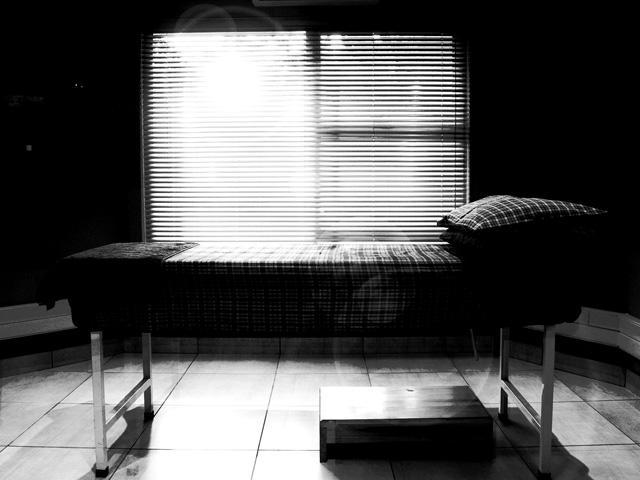
Shoulder Exercises – Rooms

Rustenburg, 0299
Tel: +27 (0)14 592 8322
Netcare Ferncrest/Life
Peglerae/Medicare
Tel: +27 (0)14 592 8322
Shoulder Rehabilitation after Rotator Cuff surgery
PROGRESSIVE EXERCISES
EXERCISES SHOULD NEVER BE EXCESSIVLY PAINFULL
REPEAT ALL EXERCISES APPROXAMITALY 10 TIMES
2 – 4 Weeks
1 - Passive flexion: (This excersice will improve the forward movement of the
shoulder).
a. Lie down comfortably on your back.
b. Fold both forearms across your chest, hold each elbow with the opposite hand.
c. Slowly lift both your arms away from the body opening up the armpits.
d. The healthy arm must do all the work, while the operated arm should just relax.
2 - Passive abduction: (This excersice will improve the outward movement of the shoulder).
a. Lie down comfortably on your back.
b. Keep your arm as straight as possible.
c. Walk/Crawl outwards with your hand to open up your armpit.
3 - Passive external rotation: (This excersice will improve the rotation of the shoulder).
a. Lie down comfortably on your back.
b. Bend your elbow 90°.
c. Allow gravity to just let the arm fall away from the body.
d. When this is comfortable:
1. Hold a stick in both hands.
2. Use the stick to gently push the hand further.
4 - Hot pack for pain and muscle spasm.
a. Put a hotpack on the affected muscles for up to 20 min.
b. Do not over heat the hotpack.
c. Be carefull not to burn.
THESE EXERCISES WILL PROGRESS YOUR PREVIOUS EXERCISES
1 - Active assisted flexion:
a. Wall crawls.
1. Stand infront of a wall.
2. Place both hands on the wall.
3. Use your fingers to crawl as high as possible up the wall.
4. When you cannot crawl higher:
a. Try to put your elbows against the wall.
b.Try to touch the wall with your forehead
5. Guide your arm down with your healthy hand.
b. Pulley 1.
1. Use a small pulley and rope attatched above your head. If you do not have this improvise using a towel/rope/tie over a rail/beam/branch.
2. Use your healthy hand to pull the operated arm up as high as possible in front of you.
3. Repeat this up and down movement.
2 - Active assisted abduction:
a. Table top/Window sill:
1. Stand an arms length away from a table or window sill facing sideways.
2. Rest your hand on the table.
3. Slowly bend your knees in order to open up the armpit as far as possible.
4. Slowly stand up.
b. Pulley 2.
1. Use a small pulley and rope attatched above your head. If you do not have this improvise using a towel/rope/tie over a
rail/beam/branch.
2. Use your healthy hand to pull the operated arm up as high as possible away from your side.
3. Repeat this up and down movement.
3 - Active assisted external rotation against wall:
a. Stand close to a wall. Face away from the wall.
b. Push your operated sides shoulder blade, buttock and elbow flat against the wall.
c. Bend your elbow 90°.
d. Use a stick to gently push your hand towards the wall.
4 - Hand behind back (HBB):
Always progress in the following order and only advance to the next exercise if possible without severe pain.
a. First touch your buttock on the same side as your operated arm.
b. Then touch the opposite buttock.
c. Then try to move your hand up to the small of your back
d. Then try to move your hand up inbetween your shoulder blades.
e. Now hold a towel behind your back and pull the hand up higher.
5 - Scapula retraction: (Pulling back shoulder blades)
a. Lie on your stomach.
b. Keep your arms at your sides.
c. Lift your shoulder blades up towards the ceiling and down to the buttocks.
d. Hold this position for 10 seconds.
6+ Weeks
1 - Light stretches: Progress weekly.
a. Hold the position for 30 secs.
b. Repeat 3 times.
2 - Active movement.
a. Flexion
1. Short arm/chicken wing: bend your elbow and move your arm forward.
2. Straight arm: keeping your arm straight move your arm forward.
b. Abduction
1. Short arm/chicken wing: bend your elbow and move your arm outward.
2. Straight arm: keeping your arm straight move your arm outward.
3 - Hand behind head.
a. Put your hand behind your head as if you are washing/brushing your hair.
b. Move your hand further down towards your neck.
4 - Scapula retraction: (Pulling back shoulder blades).
e. Lie on your stomach.
f. Keep your arms at your sides.
g. Lift your shoulder blades up towards the ceiling and down to the buttocks.
h. Lift your hand upwards toward the ceiling.
i. Hold this position for 10 seconds.
5 - Theraband exercises: NB both sides!
a. Flexion
1. Tie the theraband to a door handle. Close the door.
2. Face away from the door.
3. Hold on to the other end.
4. Slowly move your arm forwards to roughly 45°.
b. Extension
1. Face the door.
2. Hold on to the other end.
3. Slowly move your arm backwards to roughly 45°.
c. Abduction
1. Turn so that the healthy shoulder is closest to the door.
2. Hold on to the other end.
3. Slowly move your arm outwards to roughly 45°.
d. Adduction
1. Turn so that the operated shoulder is closest to the door.
2. Hold on to the other end.
3. Slowly move your arm inwards to roughly 45°.
e. External rotation.
1. Turn so that the healthy shoulder is closest to the door.
2. Hold on to the other end.
3. Bend your elbow 90°.
4. Slowly turn your arm outwards as far as possible without your elbow leaving your side. (If you struggle with this keep a small towel between the elbow and your body.)
f. Internal rotation
1. Turn so that the operated shoulder is closest to the door.
2. Hold on to the other end.
3. Bend your elbow 90°.
4. Slowly turn your arm flat against your body without your elbow leaving your side. (If you struggle with this keep a small towel between the elbow and your body.)
g. Scapula setting
1. Hold the theraband behind your back.
2. Keep your hands close together.
3. Gently pull on the theraband apart while taking your hands slightly down and backwards.
(Download the complete hospital exercise guidelines document)

Recent Comments